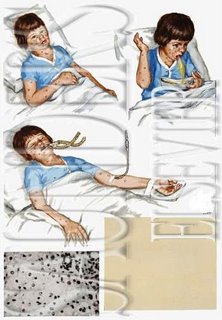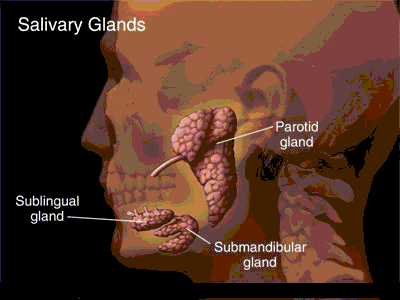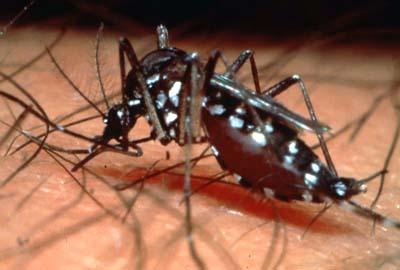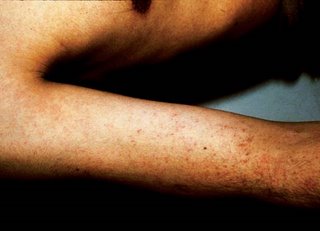| Some Stuff |
|
| Some MORE Stuff |
|
|
| Reye's Syndrome |
| Reye’s Syndrome is a condition which occurs during or immediately after a viral infection. It is seen at any age but is more common in children causing damage and swelling in the brain and liver which may lead to brain death. The signs and symptoms suddenly appear when a child is supposed to be recovering from a viral disease like measles or chickenpox. The symptoms include convulsions, persistent vomiting,lethargy, irritability, disorientation, and decline in mental alertness. These symptoms may worsen within hours leading to paralysis and loss of consciousness. Until now the cause is still unknown. Studies show that the use of aspirin for fever has been associated with its occurrence.Early diagnosis is important for prevention of irreversible complications like permanent liver damage, nervous system damage, and brain damage. The degree of severity of brain swelling is directly related to the prognosis of the affected individual.The treatment is aimed to correct the abnormalities present- brain swelling, low blood sugar, and high blood level of ammonia. |
|
|
|
| Measles |
Also known as Rubeola, measles is a rare but highly contagious disease caused by a virus. It presents like a flu with symptoms of cough, colds, red watery eyes, high grade fever, and a reddish brown rash. The rash is seen initially at the forehead then it progresses to affect later on the body until it reaches the feet. There is also the presence of small red spots inside the mouth called the Koplik’s spots. The symptoms of measles appear after around 10-14 days from exposure to the virus and usually last for 14 days. These symptoms can go on their own even without medical treatment after the virus has run its course. Treatment is given to a patient to avoid complications and to prevent progression of the disease into more severe infections like pneumonia, bronchitis, myocarditis, or encephalitis.The patient must be given antipyretic like paracetamol for the fever and more fluids to prevent dehydration. Nowadays, this condition is very rare because of immunization. The measles vaccine is available individually or in combination vaccine called MMR. The MMR vaccine is given between 12-15 months of age for the 1st dose and then repeated at age 4 to 6. It is contraindicated to individuals who are immunocompromised, and to those with allergy to gellatin and neobycin. |
|
|
|
| Mumps |
 Mumps is a viral infection primarily affecting the parotid gland on one or both sides of the face thus causing it to swell. It is caused by the Myxo Virus which is transmitted from an infected person to another by means of the saliva. The saliva of an infected person is infectious 6 days before swelling of the parotid glands begin. And the different signs and symptoms of mumps appear usually after around 3 weeks of exposure to the virus. Mumps is a viral infection primarily affecting the parotid gland on one or both sides of the face thus causing it to swell. It is caused by the Myxo Virus which is transmitted from an infected person to another by means of the saliva. The saliva of an infected person is infectious 6 days before swelling of the parotid glands begin. And the different signs and symptoms of mumps appear usually after around 3 weeks of exposure to the virus. The infected individual is usually feverish, with headache, difficulty swallowing, dry mouth, weakness, and fatigue. If the infected individual is in the post pubertal age, there may also be swelling and pain in one or both testicles which might lead to infertility. Orchitis is one of the rare complications of mumps. Others include meningitis, encephalitis, pancreatitis, hearing loss, and ovarian inflammation. Immunity is acquired after infection. Treatment is supportive with plenty of fluids and enough rest. Soft diet is recommended to aleviate the pain during swallowing. Cold compress is done for the pain or pain relievers can be given. The vaccine is given only to those who are still not exposed to the virus. Antibiotics are not recommended. |
|
|
|
| Dengue Fever/ Dengue Hemorrhagic Fever |
Dengue Fever is an infectious viral disease usually found during and shortly after the rainy season. It is common in tropical and subtropical countries like the Africa, America, Caribbean, Pacific Islands, and South East Asia. It is also known as “break-bone fever” because of the severe joint pain felt during the illness. It is transmitted by mosquito bites. The Aedes Aegypti mosquito bites an already infected person then transmit the infection to another by biting someone else.
There are four of these dengue viruses which are similar but distinct from one another. When a person gets infected with one type of virus, he gets immunity for that particular type. So that a person can get infected four times in a lifetime. The condition starts with a sudden onset of high grade fever accompanied by headache. As the disease progresses, there is appearance of a skin rash, muscle and joint pains. There can also be loss of appetite, nausea and vomiting, and enlarged lymph nodes. These symptoms usually appear after five to eight days from infection. They usually lasts up to ten days.
When a complete blood count is done to the infected individual, there is a mild increase in his WBC, increase also in his Hematocrit, and a decrease in his platelets. This condition is found in travellers so that there is usually a history of visit from the tropical areas. 
Supportive management is given to the patient. Paracetamol is given for the headache and fever. NSAIDS and aspirin are avoided because they tend to increase bleeding. Fluid intake is increased to avoid dehydration and rest is advised. The condition is generally self-limited. The problem starts when the condition progresses to Dengue Hemorrhagic Fever (DHF). This usually happens in children less than ten years of age and on their 2nd or 3rd Dengue Fever infection. It is severe and often fatal. Aside from the usual symptoms of DF, there are also signs of bleeding internally from the bowels and internal organs. Blood transfusion is usually given. No vaccine is yet available for dengue. Prevention is done by using insect repellants, mosquito nets in sleeping quarters, clothing that covers bare skin, and avoiding scents that attract mosquitoes. |
|
|
|
| Leptospirosis |
| Leptospirosis is a potentially dangerous bacterial infection which is common in tropical areas. It is transmitted to humans by infected animals especially rodents. These animals pass the bacteria in their urine which gets into the soil, vegetation, fresh water, and flood water. A person who comes in contact with the contaminated water or soil by means of swimming or wading in these areas acquires the infection.  The bacteria enters the body through the mucous membrane or through breaks in the skin. They can also be swallowed if present in contaminated drinking water. Once inside the body, they multiply in the blood and tissue and produce several signs and symptoms. Among them are headache, fever, chills, muscle pains especially in the gastrocnemius muscle, eye inflammation, nausea, and vomiting. The bacteria primarily affects the liver and kidney producing a severe condition leading to kidney failure, liver damage, jaundice, and internal bleeding. The bacteria enters the body through the mucous membrane or through breaks in the skin. They can also be swallowed if present in contaminated drinking water. Once inside the body, they multiply in the blood and tissue and produce several signs and symptoms. Among them are headache, fever, chills, muscle pains especially in the gastrocnemius muscle, eye inflammation, nausea, and vomiting. The bacteria primarily affects the liver and kidney producing a severe condition leading to kidney failure, liver damage, jaundice, and internal bleeding.
Farmers and children who love to wade in flood waters are the people at risk of having the condition. If the condition is left untreated, this might lead to damage of the internal organs and possibly lead to death. Antibiotics given as soon as possible will treat the condition. |
|
|
|
|
|